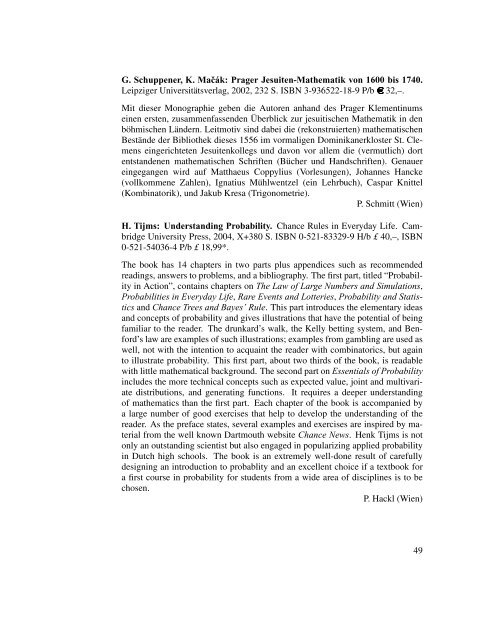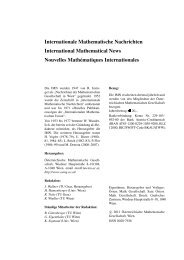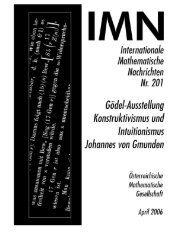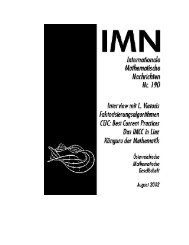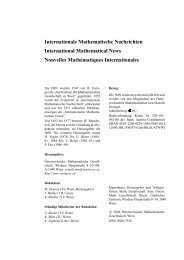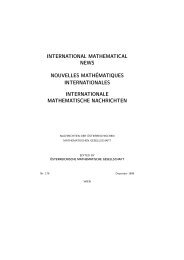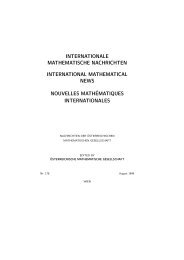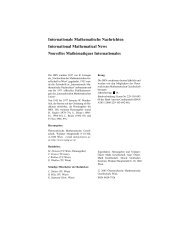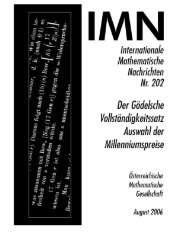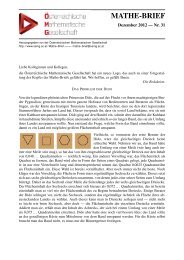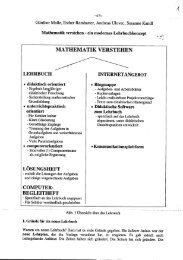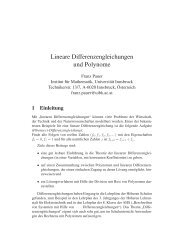199 - Ãsterreichische Mathematische Gesellschaft
199 - Ãsterreichische Mathematische Gesellschaft
199 - Ãsterreichische Mathematische Gesellschaft
Sie wollen auch ein ePaper? Erhöhen Sie die Reichweite Ihrer Titel.
YUMPU macht aus Druck-PDFs automatisch weboptimierte ePaper, die Google liebt.
G. Schuppener, K. Mačák: Prager Jesuiten-Mathematik von 1600 bis 1740.<br />
Leipziger Universitätsverlag, 2002, 232 S. ISBN 3-936522-18-9 P/b 32,–.<br />
Mit dieser Monographie geben die Autoren anhand des Prager Klementinums<br />
einen ersten, zusammenfassenden Überblick zur jesuitischen Mathematik in den<br />
böhmischen Ländern. Leitmotiv sind dabei die (rekonstruierten) mathematischen<br />
Bestände der Bibliothek dieses 1556 im vormaligen Dominikanerkloster St. Clemens<br />
eingerichteten Jesuitenkollegs und davon vor allem die (vermutlich) dort<br />
entstandenen mathematischen Schriften (Bücher und Handschriften). Genauer<br />
eingegangen wird auf Matthaeus Coppylius (Vorlesungen), Johannes Hancke<br />
(vollkommene Zahlen), Ignatius Mühlwentzel (ein Lehrbuch), Caspar Knittel<br />
(Kombinatorik), und Jakub Kresa (Trigonometrie).<br />
P. Schmitt (Wien)<br />
H. Tijms: Understanding Probability. Chance Rules in Everyday Life. Cambridge<br />
University Press, 2004, X+380 S. ISBN 0-521-83329-9 H/b £ 40,–, ISBN<br />
0-521-54036-4 P/b £ 18,99*.<br />
The book has 14 chapters in two parts plus appendices such as recommended<br />
readings, answers to problems, and a bibliography. The first part, titled “Probability<br />
in Action”, contains chapters on The Law of Large Numbers and Simulations,<br />
Probabilities in Everyday Life, Rare Events and Lotteries, Probability and Statistics<br />
and Chance Trees and Bayes’ Rule. This part introduces the elementary ideas<br />
and concepts of probability and gives illustrations that have the potential of being<br />
familiar to the reader. The drunkard’s walk, the Kelly betting system, and Benford’s<br />
law are examples of such illustrations; examples from gambling are used as<br />
well, not with the intention to acquaint the reader with combinatorics, but again<br />
to illustrate probability. This first part, about two thirds of the book, is readable<br />
with little mathematical background. The second part on Essentials of Probability<br />
includes the more technical concepts such as expected value, joint and multivariate<br />
distributions, and generating functions. It requires a deeper understanding<br />
of mathematics than the first part. Each chapter of the book is accompanied by<br />
a large number of good exercises that help to develop the understanding of the<br />
reader. As the preface states, several examples and exercises are inspired by material<br />
from the well known Dartmouth website Chance News. Henk Tijms is not<br />
only an outstanding scientist but also engaged in popularizing applied probability<br />
in Dutch high schools. The book is an extremely well-done result of carefully<br />
designing an introduction to probablity and an excellent choice if a textbook for<br />
a first course in probability for students from a wide area of disciplines is to be<br />
chosen.<br />
P. Hackl (Wien)<br />
49


